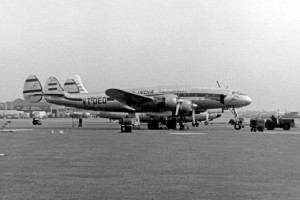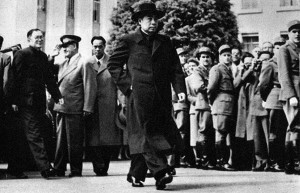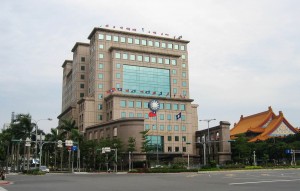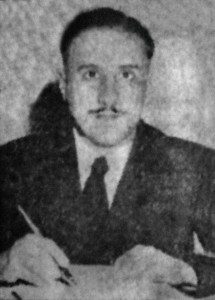Published on April 11, 2013
Today in aviation history, on the evening of April 11, 1955, precisely five hours into its flight to Jakarta, Indonesia, the chartered Air India Lockheed L-749 Constellation “Kashmir Princess” was suddenly rocked by an explosion. An instant later, the pilots saw flames streaming from behind the number three engine on the right wing. Smoke began to fill the cockpit. As the captain shut down and feathered the number three engine, he saw too that the fire warning light for the baggage compartment was illuminated. A fire in the cargo hold, a fire on the wing, and smoke in the cockpit were an extraordinary, life-threatening emergency. As the captain pointed the plane’s nose downward toward the sea, he hoped to ditch the plane into the water so that the survivors could escape in life rafts. A distress call was transmitted, declaring the airliner’s position over the Natuna Islands.
Moments later, the radio went dead as the electrical system in the airplane began to fail, along with other critical systems as the fire spread below.

Crash and Questions
Ultimately, the captain’s last hope of ditching the plane in the water was unsuccessful. All of the passengers and some of the flight crew — sixteen in all — perished in the crash that followed. Somehow, three crewmen survived, including the first officer, the flight engineer and the navigator, who would later make clear statements of the events on board. What made this more than just another plane crash was one thing — China’s Premier, Zhou Enlai, was supposed to have been on board, though he had cancelled at the last moment after citing an emergency medical surgery need, but then three days later had proceeded to Jakarta via Rangoon instead.
In the post-accident evaluation, investigators wondered whether the crash had been an accident after all — could it have been an assassination attempt gone wrong? They also asked themselves, why had Zhou Enlai cancelled his journey on that plane at the last minute but gone via another means?

Zhou Enlai’s Close Shave
As the investigation proceeded in the months after the crash, a number of strange coincidences and unexpected twists began to emerge. The full evaluation of the events determined that an explosion had taken place in the plane’s wheel well. That, in turn, had ignited fires in the baggage compartment and on the right wing. The most obvious explanation was a bomb mixed in with the passenger bags. Yet the passengers themselves were all officials and journalists heading to a conference — three were Chinese government officials, three were Chinese journalists and the rest were a mix of Vietnamese and East European delegates. All were heading to the Asia-Afro Bandung Conference in Jakarta, Indonesia, flying on an Air India flight that the Chinese government had chartered for the conference. Three days later, Zhou Enlai arrived at the conference, apparently having never undergone any emergency surgery at all.

To the investigators, it made no sense for one of them to have brought a bomb on board in a suicidal bid to down the plane. The fact that originally Zhou Enlai was supposed to have been on board was strong circumstantial evidence pointing to an assassination attempt, but by whom? Interviews were conducted with all of the ground crew, fuel truck staff and baggage handlers who might have had access to the plane at its points of origin as well as in Hong Kong, where the flight had made a stop en route to Jakarta. All of the personnel checked out and were proven to be innocent, except for one Hong Kong janitor working for an airport contractor. Quite simply, the man who investigators had originally identified as the lowly janitor, Chow Tse-Ming, was missing. Was it coincidence or could he have been the bomber?

The Mystery of Chow Tse-Ming
As investigators and police chased leads about Chow Tse-Ming, they began to unravel a mystery. Apparently, Chow Tse-Ming was an alias; in fact, two other aliases for the same man were also uncovered. As well, in the days leading up to the bombing and crash of the plane, they learned that Chow Tse-Ming had been spending a lot of money around Hong Kong, as if living it up based on income or savings that an airport janitor shouldn’t reasonably have. Perhaps he had been paid to plant the bomb? Finally, his disappearance from Hong Kong was finally traced to him having departed quietly on a Civil Air Transport (CAT) flight to Taiwan. As the Chinese knew all too well, CAT was a frequent CIA contract air carrier, though it also flew other airline operations and cargo flights around the region.
Fingers began pointing at the Central Intelligence Agency as the possible culprit, though a competing theory soon emerged when others considered that the CAT flight had delivered Chow Tse-Ming to Taiwan. Indonesian investigators reported that amidst the wreckage, they had identified an American-made MK-7 detonator device, adding fuel to the fire. The British-run Hong Kong police surmised that it seemed likely that the man was an agent of the Kuomintang’s intelligence operations arm, a theory which the Chinese also felt had validity — undoubtedly, the CIA had supplied MK-7 triggers to Taiwan.
Despite the evidence that the events were of Taiwanese origin, in the years that followed, the Chinese asked the Nixon White House twice about the events of the plane’s bombing and whether the CIA had been involved, expecting that perhaps the attempt had been a joint CIA-KMT operation. In response to the second request, Henry Kissinger quietly noted that the Chinese thought far too highly of the CIA’s actual abilities. Ultimately, the evidence was compelling but not conclusive that the Kuomintang Government of Taiwan had attempted to assassinate the Chinese Premier, Zhou Enlai, and had failed, killing 16 innocent people in the process.

The Question of Chinese Complicity
Years after the bombing, the Chinese government released a series of documents that painted a very different picture of the events of April 11, 1955, when the Kashmir Princess crashed. In the documents, it was learned that Zhou Enlai had been tipped off about the upcoming bombing of the Kashmir Princess. Rather than cancel the flight and lodge a protest, he had assigned lower level Chinese cadre officials onto the airplane as well as a set of journalists (as their presence would result in a wider array of press coverage).
Knowing that all of those going onto the plane would surely die, he simply let the events happen, hoping to gain political advantage as well as cover for a secret trip to Rangoon for a meeting with the government there. Three days later, he would emerge in Jakarta for the conference, riding a wave of positive press coverage in the wake of an attempted assassination that had gone wrong and killed innocent people. The plan worked, though not as well as Zhou Enlai might have hoped — the investigation into the crash took far longer than a few days and ultimately, the culprits were never firmly established.

Aftermath
The bombing of the Kashmir Princess is a sad tale, in which 16 innocent people died needlessly, pawns in a larger political game to which they played little or no part. The captain of the Air India plane, Capt. D. K. Jatar, as well as his flight crew members, M.C. Dixit and Anant Karnik, were professionals who didn’t deserve to be caught up in espionage operations and failed assassination attempts. That Taiwan attempted the assassination of Zhou Enlai is both despicable but also understandable in those times of Cold War intrigue and conflict. That China knew in advance and did nothing to prevent the bombing is equally immoral and, against virtually any ethical yardstick, is virtually indefensible.
Looking back, we can only be glad that the dark days of the Cold War have ended, even if the question of Taiwan’s future remains open. Such deeds in a cloak and dagger world of “wet work” — the parlance of Cold War assassins — are hallmarks of a time long past, even if politically-motivated assassinations have continued even up to this day. More recently, the news has reported the allegedly Russian sponsored radioactive poisoning of Alexander Litvinenko in London and the 2004 poisoning of Viktor Yushchenko, as well as targeted assassinations undertaken by Israel’s Mossad in Dubai of the Hamas senior official, Mahmoud Al-Mabhouh, among others.
Thankfully, however, none of those have involved the bombing of airliners. The world, it would seem, has come a long way since the early days of the Cold War.
From the Archives
Italy’s Darkest Night — read about what might have been a French-attempted assassination of Muammar Qaddafi, which ended up shooting down an airliner over the Mediterranean.

My father, Anant Karnik, was one of three survivors of this event. He turns 90 this year. He still suffers nightmares at times of swimming in an ocean surrounded by burning wreckage an flames that he felt were over 50 ft high.
Holy moly…I can only imagine what it must have been like for him to go through that ordeal.
Mr. Milind,
Salute to your father and other two brave-hearts (Capt. Dikshit and J. S. Pathak). The sea was notorious for sharks!
I am writing this thriller incidence, at full length, along with pictures, illustrations and maps, in my magazine named “SAFARI”. I could not find a single photo of your father (A S Karnik). I request you to provide me one so that I can print it.
Thank you!
Harshal Pushkarna
harshalpushkarna@gmail.com
Dear Harshal,
That article sound really interesting and I would love to know more about these people and their bravery. Could you post a link to that article? Would love to read it.
My cousin, Gloria Berry, was the air hostess on this flight. She was awarded the Ashok Chakra for bravery.
There is a very good book about the tragic crash of the “Kashmir Princess” that was written by Colonel AK Mitra. He was Military, Naval and Air Attaché in the Indian Embassy at Jakarta. His book tells a lot of the story and background to the events.
It was tragic that so many died, including the Captain, and the 23 year old flight attendent, Gloria Berry, who died. She was soon to be married. I would like a photo of her as I am writing a book about brave cabin crew members. If anyone can help, please contact me. I am an author of the upcoming.
Kind regards,
George Banks
Milind,
My uncle Joe Pimenta was one of the pursers on that flight. Great guy from what I hear. I read your father’s book when I grew up and it so well described the flight and the aftermath. Brave man, your Dad.
Ivan Menezes
Milind,
Firstly all my love and affection goes out to your father. A real hero, we don’t see many of them these days. I read that your father had written a book about his ordeal. Do you know where I could get it? Please post the link here!
Hi,
I believe the book is now out of print. It has been archived at https://archive.org/stream/in.ernet.dli.2015.127556/2015.127556.Kashmir-Princess_djvu.txt
I was able to get a download from there.
My deepest respects to the three brave survivors and to the valiant crew that lost their lives so many years ago.
I read “Kashmir Princess” after 60 years again. I met Mr. M.C Dixit, co pilot in in Indore. His nephew was my schoolmate. These are great heros. God bless.
Condolences. I read that Mr. Karnik passed away recently at 92 years old. I heard that he wrote two books, one about the Kashmir Princess. His twin brother, Capt. M C. Dixit, was still alive as he was recorded to have voted in Delhi at age 102. God bless them both.
Hello Milind,
I am producing a show on the Kashmir Princess conspiracy for a news channel. May I get your contact number?
Jai Shankar
Would be happy to talk to you.
Thanks
— Milind
It is utterly despicable to try to also blame China for the death of the passengers and crew of the Kashmir Princess. The CIA and its Kuomintang partners, who had been blatantly flying their U2 spy planes at very regular intervals over every part of China those days with total disregard to the sovereignty of other countries, would most certainly have knowledge of the mid-air explosion in 1955. How could the Chinese authorities have any foreknowledge of such a wicked act of terrorism to sabotage the Kashmir Princess, especially when China had just established the Peoples‘ Republic just a few year ago in 1949. It had neither the resources nor the man power to be able to do much surveillance in territories not under their control. Whatever reports and stories that emerged later from the Chinese press were merely unofficial speculations. However, revelation by certain scholars and some of the CIA operatives many years later did point the fingers at the KMT Secret Services, with covert cooperation with the CIA. Your article has also failed to mention that the Chinese premier had made appointment to consult Nehru, the Indian PM and U Nhu, the Burmese leader in Rangoon before attending the Bandung Conference. That Rangoon rendezvous with the other two regional leaders had saved Mr. Zhou Enlai from being liquidated by the enemies of China.
I salute to those heroes for their victory. I read about the incident in Safari magazine.
Gloria was the stewardess who helped a young couple take care of their baby girl in a documentary film called “Highlights of the Sky”. The couple were Mr and Mrs C. P. Vijayaraghavan and the infant was me! My parents told me about her tragic death in the 1955 air crash of the Kashmir Princess. I would love to see the film if it is still available in the Film’s Division archives.
Dear Mr. Milind —
What a coincidence it is that I find an opportunity to speak my mind to you about both the thriller book, Kasmir Princess, and your octogenarian father AS Karnik. I am surprised that I join you through this portal communicating my message to you.
I am in frantic search of the book which I read in 1961 when I was just around ten years bought by my father, a police officer in Burdwan Police Station. After reading it, the book had left an indelible mark on me about what had happened in Great Natuna Island near Djakarta as penned by your father, AS Karnik. I vividly recall the descriptions and pictures of crew members, especially that of Gloria Berry.
Now, at this age of 70 years, as a bookaholic, I want to get a copy of the book which was misplaced or lost from our family collection long, long ago. After performing an internet search, I found some clues on the matter, including that I shoudl write or send an email to Jaico Book Publishers in Bombay, Calcutta, and Chennai, and Dasgupta Books in Calcutta to procure any subsequent editions published after 1958. I have no response yet, however, from Jaico book publishers.
May I request that you try to find a copy for me? If you reply in the affirmative, I shall be gratefully acknowledge. My heart reaches out to your father of 91 years — and htis from a reader of 70 years old.
Awaiting your mail response.
Regards,
Arun Kumar Baks
Calcutta
09903378319
Mr M V Dixit lives here in Samachar Aptts where I am also residing . He is 100 years plus .
I would like to know more about this aircraft and the mishap
Hello. I recently wrote an article on The Kashmir Princess. This topic is very close to me as my grand-uncle was D. K. Jatar, the captain who manned the aircraft. In the article I discuss the crash itself and also the power of the incident to shift the power dynamics of that time. The link to the article is attached below.
The Kashmir Princess- https://exhibitfive.home.blog/2020/04/01/the-kashmir-princess/
Since this book “Kashmir Princess” (published in 1958) is a first hand account of the most mysterious accident ever happened involving an Indian airliner and must be an all-time favourite for the aviation history enthusiasts like me, but unfortunately this priceless book is no longer available in the market/online stores in India. I was fortunate to have recently procured the another invaluable book on the incident written by Col. A. K. Mitra. Now since I came to know about this book by Mr. Karnik I would love to have a copy of the book at any price justifying its present value, should anybody wants to part with it. He may contact me on my email – chandansen4@rediffmail.com.
I would also request Mr. Millind Karnik to consider publishing a reprint version of his father’s anecdote. I am sure it will be a great benefit to the new generation readers.
My father’s book is no longer in publication. I have one copy left. I will definitely look into publishing a reprint
Thanks
— Milind
Any progress? I searched for the book but to no avail. Requesting you to please get the book reprinted ASAP. That book needs to be in my shelf, a gem of a book.
Regards